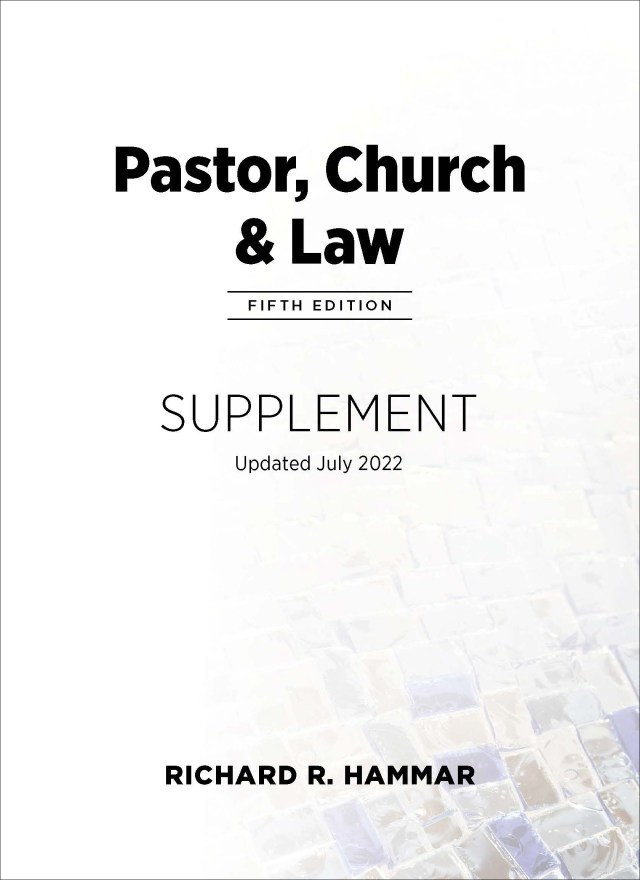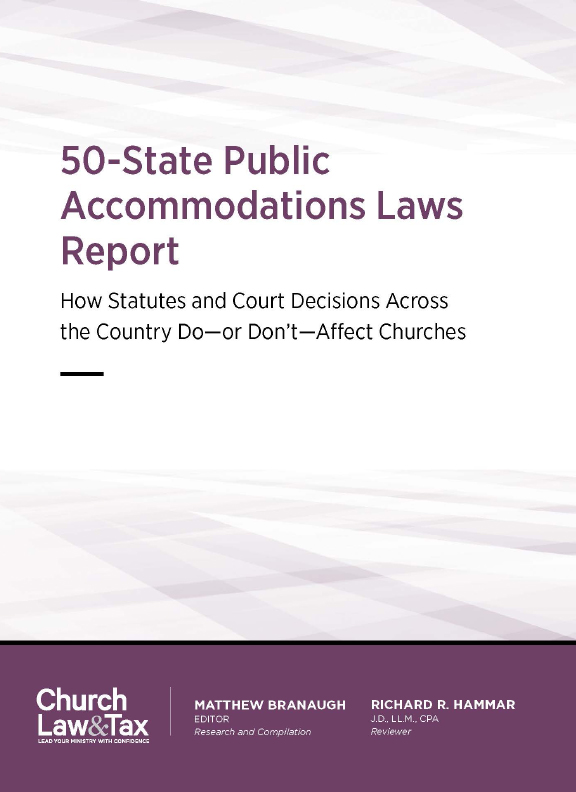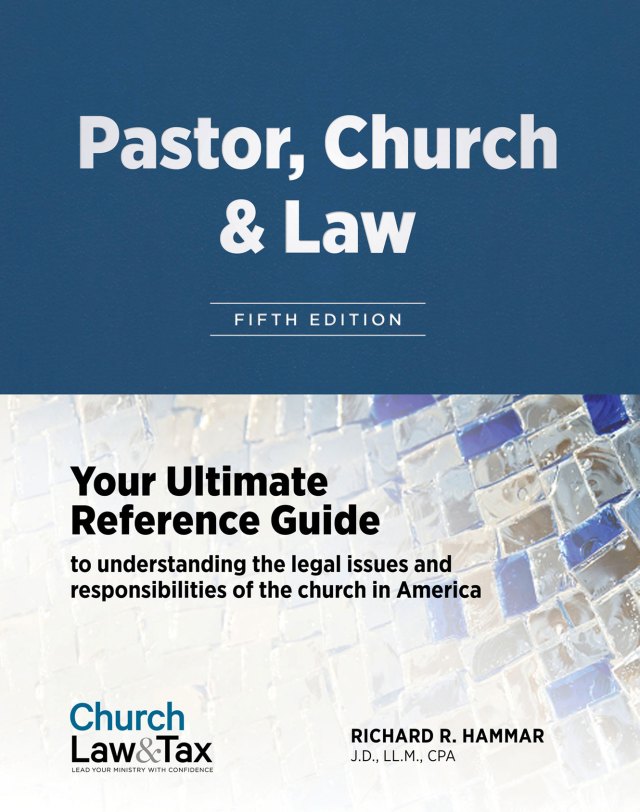An adult Muslim male (the “plaintiff”) was converted to Christianity at a Presbyterian church in Oklahoma, and was thereafter baptized. The plaintiff alleges that he made the church and its pastor (the “defendants”) aware of the need for confidentiality throughout the conversion process, as he was planning to return to Syria. The plaintiff was baptized during a service that was open to members and guests of the church, but it was not broadcasted live. The church, however, later posted a recording of the baptism on its website. The plaintiff was not, and never became, a member of the defendant church before or after his baptism. Doe v. Presbyterian Church, 2017 WL 712811 (Okla. 2017).
Following his baptism, the plaintiff travelled to Syria. Radical Muslims in Damascus who had heard of his conversion on the internet confronted him shortly after his arrival. The plaintiff claims that he was kidnapped, bound, blindfolded, beaten, and informed that he was going to be put to death as a result of his conversion. He was tortured and forced into a 55-gallon electrified drum for long stretches of time. After several days, he was informed that his death sentence was to be carried out by beheading. He was ultimately able to free his hands, acquire a firearm, and use it to escape, killing his uncle in the process. Shortly afterward, he was stabbed in the chest by his cousin as retribution for the death of the uncle. The plaintiff claimed that he was able to clandestinely make it back to the United States, where he faces continuous death threats. He claims to have suffered numerous physical and psychological injuries, all due to the defendants’ publication of his baptism, contrary to the promises they supposedly made to him that it would be kept confidential.
The plaintiff sued the defendants, alleging breach of contract, negligence, and emotional distress. The defendants asked the court to dismiss the lawsuit on the ground that the civil courts lacked jurisdiction over ecclesiastical matters, which included the theology, usage and customs, and written laws of the church that controlled the ritual and publication of the plaintiff’s baptism.
The plaintiff insisted that First Amendment protection applies only to religious beliefs, not actions based on them, such as the publication of his baptism.
The trial court ultimately granted the defendants’ motion to dismiss based on a lack of jurisdiction. It concluded that the church’s sacrament of baptism gave it exclusive “ecclesiastical jurisdiction” over questions centered on the performance of the sacrament, and this included, pursuant to the Presbyterian Constitution, Book of Order, and church practices, the public nature of the sacrament and its publication online. The plaintiff appealed to the Oklahoma Supreme Court.
The “church autonomy doctrine”
The court began its opinion with a review of the “church autonomy doctrine.” It observed: “Civil courts are prohibited from reviewing internal church disputes involving matters of faith, doctrine, church governance, and polity …. Sometimes called the ‘church autonomy doctrine,’ this principle is rooted in the Free Exercise and Establishment Clauses of the First Amendment to the United States Constitution.”
The court noted that “the framework for the church autonomy doctrine was set out by the Supreme Court of the United States in Watson v. Jones, 80 U.S. 679 (1871).” In that decision, the Court explained:
In this country the full and free right to entertain any religious belief, to practice any religious principle, and to teach any religious doctrine which does not violate the laws of morality and property, and which does not infringe personal rights, is conceded to all. The law knows no heresy, and is committed to the support of no dogma, the establishment of no sect. The right to organize voluntary religious associations to assist in the expression and dissemination of any religious doctrine, and to create tribunals for the decision of controverted questions of faith within the association, and for the ecclesiastical government of all the individual members, congregations, and officers within the general association, is unquestioned. All who unite themselves to such a body do so with an implied consent to this government, and are bound to submit to it. But it would be a vain consent and would lead to the total subversion of such religious bodies, if any one aggrieved by one of their decisions could appeal to the secular courts and have them reversed. It is of the essence of these religious unions, and of their right to establish tribunals for the decision of questions arising among themselves, that those decisions should be binding in all cases of ecclesiastical cognizance, subject only to such appeals as the organism itself provides for.
Nor do we see that justice would be likely to be promoted by submitting those decisions to review in the ordinary judicial tribunals. Each of these large and influential bodies (to mention no others, let reference be had to the Protestant Episcopal, the Methodist Episcopal, and the Presbyterian churches), has a body of constitutional and ecclesiastical law of its own, to be found in their written organic laws, their books of discipline, in their collections of precedents, in their usage and customs, which as to each constitute a system of ecclesiastical law and religious faith that tasks the ablest minds to become familiar with. It is not to be supposed that the judges of the civil courts can be as competent in the ecclesiastical law and religious faith of all these bodies as the ablest men in each are in reference to their own. It would therefore be an appeal from the more learned tribunal in the law which should decide the case, to one which is less so.
Over the years, the Supreme Court of the United States has continued to refine and apply the church autonomy doctrine. For example, in Kedroff v. St. Nicholas Cathedral, 344 U.S. 94 (1952), the Court noted that the Watson decision
radiates a spirit of freedom for religious organizations, an independence from secular control or manipulation, in short, power to decide for themselves, free from state interference, matters of church government as well as those of faith and doctrine. Freedom to select the clergy, where no improper methods of choice are proven, we think, must now be said to have federal constitutional protection as a part of the free exercise of religion against state interference.
The United States Supreme Court has also noted that the church autonomy doctrine applies beyond selection of clergy and doctrine-related disputes over church property, to other internal matters including disputes over (1) polity, (2) church administration, and (3) employment discrimination claims concerning the qualifications and hiring of ministers.
Significance of church membership
The Oklahoma Supreme Court noted that the plaintiff never became an official member of the defendant church. The plaintiff argued that this demonstrated that he had not consented to the church’s ecclesiastical jurisdiction. But the court noted that while the plaintiff never became a member of the church “he consented—and in fact specifically requested—to be baptized into the Christian faith” at the church by the defendant pastor. The court continued: “Applying the … church autonomy doctrine, the courts lack jurisdiction over any actions related to the plaintiff’s baptism that are rooted in religious belief, even if he was not a full member of the church or later broke off any connection to the church.”
However, the court noted that “it was not the baptism itself of which the plaintiff complains. Rather, his … claims are predicated on his baptism’s publication on the internet, which he claims resulted in his relatives’ discovery of his baptism while he was in Syria.”
The court’s decision
The court concluded that the central question in this case was whether “the publication of the plaintiff’s baptism on the internet was an act rooted in religious belief such that it occurs in the context of the church’s ecclesiastical jurisdiction.” The court concluded that it was, based on the following facts:
1. The Constitution of the Presbyterian Church (USA) provides for two sacraments, one of which is baptism. The public nature of baptism is an integral part of the Presbyterian Church’s understanding of the sacrament. For example, the Constitution of the Presbyterian Church (USA) provides: “By baptism, individuals are publicly received into the church to share in its life and ministry.”
2. The Book of Order, which is the second part of the Constitution of the Presbyterian Church (USA), provides that “baptism is celebrated in a service of public worship” outside of extraordinary circumstances, such as in hospitals and prisons.
3. The Book of Order further outlines the responsibilities of the session (i.e., the church’s governing board) for baptism, including that it is responsible for:
- Admitting to baptism, after appropriate instruction and examination, those not yet baptized who come making public their personal profession of faith, placing all baptized persons on the appropriate roll as members of the congregation.
- The session is also required to maintain the register of baptisms: “There shall be registers of baptisms authorized by the session, of ruling elders and deacons, of installed pastors with dates of service, and such other registers as the session shall deem necessary.”
4. The defendant church’s ruling elder testified concerning the public nature of baptism that:
- “The sacrament of Baptism within the PCUSA churches is a church ritual celebrated in a ceremony of public worship. Baptism is considered a public profession of faith.”
- “Any Baptism conducted by the church is required to be memorialized or recorded in the Parish Register. All baptisms are traditionally reported and published in congregation publications as part of the celebrated life of the church.”
- “Churches throughout Eastern Oklahoma Presbytery publish the names of those being baptized in their Sunday Bulletins and newsletters, which are also frequently made available on the World Wide Web.”
- The defendant church “has announced and listed the names of all those being baptized in the Sunday Bulletin since I began attending the church in 1983. These customs are based on the Presbyterian belief that Baptisms are public declarations of faith and should be celebrated publicly.”
5. In his own affidavit, the defendant pastor stated he performed the plaintiff’s baptism in a “public service open to all members and guests of the church.” He further stated: “After being called to the front of the church, plaintiff voluntarily walked forward, identified himself, and expressed his desire to be baptized by me in front of all members and guests present.” The pastor’s affidavit further explained:
- “Baptism is a declaration of the Christian faith and is celebrated publicly. All baptisms performed at the Church are required by the Constitution to be reported and recorded in the Parish Register.”
- “In accordance with the belief that baptism is a public declaration of faith, it is the longstanding custom and practice of the church each week to report in the Sunday bulletin the name of any person who was baptized the previous Sunday. This has been the custom and practice of the church since before my becoming senior pastor of the Church in 1992.”
- “The bulletin, or Order of Worship, is a written publication, customarily distributed to attendees of Sunday worship services, delivered to individuals who are unable to attend services in person, and made available on the Church’s website.”
- “Plaintiff’s name was listed in the bulletin the week after his baptism in keeping with the tradition, custom, and practice of the church. Plaintiff never requested that the church depart from its normal practices in conducting his baptism.”
The court concluded:
The manner in which the plaintiff’s baptism was conducted, including its subsequent publication online, was rooted in religious belief. The context of the online posting of the plaintiff’s baptism is not secular. His tort claims all rest on an act that, per church doctrine, is an integral part of what the church considers to be the public nature of the sacrament. Because his claims arise from the performance of his baptism, this dispute is one over ecclesiastical rule, custom or law, and is not purely secular …. The defendant church has the right to conduct the sacrament of baptism in accordance with custom and doctrine, even if doing so resulted in alleged [damages] against the plaintiff, who himself requested the sacrament be administered.
It must be noted that our holding is a limited one, given the manner in which the plaintiff’s claims are inextricably tied to the doctrinal requirements of baptism. We are not … establishing here that the courts lack jurisdiction over all religiously-motivated tort claims. The plaintiff’s tort and contract claims in this matter cannot be separated from the doctrinal requirements of the baptism he asked for, performed by the defendant church and pastor. It is this entanglement that moves this dispute into the realm of one about discipline, faith, internal organization, or ecclesiastical rule, custom, or law ….
Recognizing the importance of the autonomy of religious institutions within the framework of the United States legal system, the courts must refrain from undue interference with religious beliefs and practices. The plaintiff exercised his right to convert to Christianity and accord his religious beliefs with the demands of his conscience. Similarly, the defendant church and pastor exercised their right to perform the sacrament of baptism in accordance with the doctrine and a custom of the church. It is not the role of the courts to adjudicate a dispute between [the parties] over the publication of the plaintiff’s baptism in accord with church practice, even if he was harmed by his baptism and its subsequent publication. Per the church autonomy doctrine, the courts lack subject matter jurisdiction over the matter.
Relevance to other churches
This case is relevant for several reasons.
First, the court provided an excellent summary of the church autonomy doctrine, which deprives the civil courts of jurisdiction to resolve internal church disputes involving “matters of faith, doctrine, church governance, and polity.” This doctrine extends, at a minimum, to the following disputes:
- selection of clergy,
- doctrine-related disputes over church property,
- disputes over polity,
- disputes involving church administration, and
- employment discrimination claims concerning the qualifications and hiring of ministers.
The court concluded: “The manner in which the plaintiff’s baptism was conducted, including its subsequent publication online, was rooted in religious belief.”
Second, the court concluded that the church autonomy doctrine can be applied to nonmembers. It rejected the plaintiff’s argument that this doctrine did not negate his claims since he had never become a church member and therefore had not consented to the exclusive ecclesiastical jurisdiction of the church. The court acknowledged that the plaintiff never became a member of the defendant church, but concluded that this did not negate application of the church autonomy doctrine since he had consented to, and requested, baptism. The court concluded that under the church autonomy doctrine, the civil courts “lack jurisdiction over any claims related to the plaintiff’s baptism that are rooted in religious belief, even if he was not a full member of the church or later broke off any connection to the church.”
Third, and most importantly, the court concluded that the church autonomy doctrine deprives the civil courts of jurisdiction not only to resolve internal church disputes involving matters of “faith, doctrine, church governance, and polity,” but also collateral claims that are inextricably intertwined with these core ecclesiastical principles. The court concluded that the central question in this case was whether “the publication of the plaintiff’s baptism on the internet was an act rooted in religious belief such that it occurs in the context of the church’s ecclesiastical jurisdiction, with the result that the plaintiff’s claims based on the publication cannot be sustained in the civil courts.” The court concluded that it was, based on passages in the governing documents of the Presbyterian Church, and the testimony of church officials, defining baptism as an intrinsically public rite.
Fifth, church leaders should consult with legal counsel before posting information on the internet that could result in legal claims against the church, even if the information is intertwined with church doctrine.
While not every posting on a church’s website or social media will be protected against civil liability by the church autonomy doctrine, posts that are “rooted in religious belief,” and that are inextricably tied to the doctrinal requirements,” may be. The court concluded: “We are not … establishing here that the courts lack jurisdiction over all religiously-motivated tort claims. The plaintiff’s tort and contract claims in this matter cannot be separated from the doctrinal requirements of the baptism he asked for, performed by the defendant church and pastor. It is this entanglement that moves this dispute into the realm of one about discipline, faith, internal organization, or ecclesiastical rule, custom, or law.”
Fourth, a dissenting justice asserted that the church autonomy doctrine did not apply to this case since it did not involve “a question of discipline, faith, or ecclesiastical rule decided by a church tribunal, nor does it involve an internal, administrative matter.” Rather, it merely involves “the church’s publication of the plaintiff’s name on the internet.” The dissenting justice concluded:
Baptism is an important aspect of the church’s doctrine, and the public nature of baptism is an essential part of the sacrament. The plaintiff, however, is not alleging that the baptism caused his injuries, nor that any member of the congregation viewing the baptism caused the injuries. His claim is limited to the baptism’s publication online …. There is no codified doctrine that demonstrates the church’s policy on this issue. The church’s Book of Order requires that baptisms be recorded, and these are memorialized in the parish register, but again, the plaintiff is not alleging that his injuries were caused by his name’s appearance in the parish register. His claim is limited to the baptism’s publication online …. There is a significant distinction between the baptism, an action deeply rooted in religious belief, and the publication of the plaintiff’s name on the internet, an action not deeply rooted in religious belief …. The protections guaranteed by the First Amendment are an indispensable aspect of our body of law. They, however, are not implicated in this case. Allowing the plaintiff to bring his claims does not interfere with an internal administrative matter nor a question of faith or ecclesiastical rule. Instead, the case implicates the posting of a name on the World Wide Web. If this is an action deeply rooted in religious belief, what isn’t?
Fifth, church leaders should consult with legal counsel before posting information on the internet that could result in legal claims against the church, even if the information is intertwined with church doctrine.





